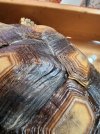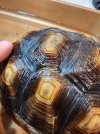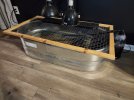eachdayisnew
New Member
Hello,
Looking for someone who has some knowledge or experience on something we are seeing on our Sulcata.
We noticed tonight that there are two spots on its back that appear to almost be cracks between the scutes. A corner of one is lifted and then there is what looks like a crack between two others.
We soaked it good tonight and neither spot seemed to be bothersome to it when we dripped or brushed it with water. The plastron looks good and the shell is firm all the way around him. Ours is about 22 months so definitely still on the younger and smaller side.
Looking online there so many discussions about pyramiding, shell rot, scud, and metabolic bone disease but so very few pictures that I'm having a hard time finding good information. I've posted some pictures of what we are seeing and am thankful for any advice or experience you may have. Thank you!



Looking for someone who has some knowledge or experience on something we are seeing on our Sulcata.
We noticed tonight that there are two spots on its back that appear to almost be cracks between the scutes. A corner of one is lifted and then there is what looks like a crack between two others.
We soaked it good tonight and neither spot seemed to be bothersome to it when we dripped or brushed it with water. The plastron looks good and the shell is firm all the way around him. Ours is about 22 months so definitely still on the younger and smaller side.
Looking online there so many discussions about pyramiding, shell rot, scud, and metabolic bone disease but so very few pictures that I'm having a hard time finding good information. I've posted some pictures of what we are seeing and am thankful for any advice or experience you may have. Thank you!




